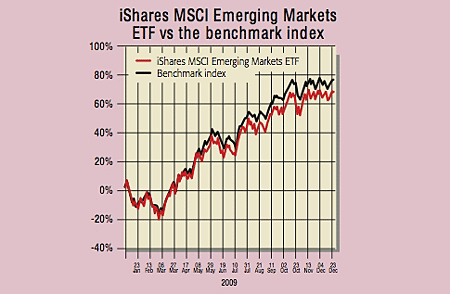
Most active managers fail to beat their benchmarks. This is a key selling point for exchange-traded funds (ETFs) – if you can’t beat the market, you may as well track it. But a recent study by Morgan Stanley shows you can’t always depend on ETFs to deliver the market return either. In 2009, the average US ETF underperformed its index by 1.25% in 2009, from 0.52% in 2008. Management fees account for just 0.3% of this gap. So what’s going on?
To be fair to ETFs, part of the divergence is down to a mathematical optical illusion. Fees are levied daily within ETFs. So the tracking difference will always seem larger in rising markets and smaller in falling ones. So 2009’s huge rally accounts for some of the rise in tracking error. But it’s also partly down to ETFs moving into more esoteric areas of the market.
Take, for example, iShares’ benchmark MSCI Emerging Markets fund, one of the largest American ETFs. The fund returned 71.8% in 2009, compared to 78.5% for the index. But the Europe-listed version of the iShares fund did a little better, returning 75.4%, while db x-trackers’ MSCI Emerging Markets ETF returned 77.5%.
Why? The iShares ETFs, which track the index by physically owning the underlying stocks, held a lot of “offshore” emerging market shares – ADRs and GDRs – particularly in the US version. The performance of ADRs and GDRs last year differed from the locally listed shares used in the index calculation, so the fund and benchmark returns didn’t match up.
The db x-trackers fund, on the other hand, uses swap-based replication, where the parent bank guarantees the index return to the fund (less fees). This should mean better tracking, though at the expense of some risk exposure to the bank involved.
Tracking error is not all one way. Some ETFs beat their indices. This can happen because of differing tax treatment of dividends between fund and index, or because the fund is making extra returns from another source, such as lending its stocks (although this isn’t risk-free).
So check out an ETF’s tracking ability before you buy. Simply look at the issuer’s website and compare the fund return with the index return over different periods. Funds tracking popular benchmarks, such as the FTSE 100, S&P 500 and Euro Stoxx 50, should have few problems. But for less liquid or more exotic areas – emerging markets, corporate bonds, or small-caps – tracking error could be a real concern.
• Paul Amery is editor of
www.indexuniverse.eu
, the top source of news and analysis on Europe’s ETF and index fund market.